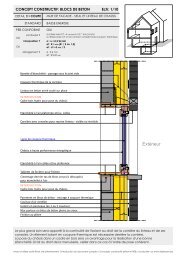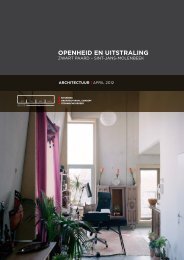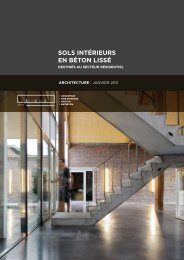Fire Safety and Concrete Structures - Febelcem
Fire Safety and Concrete Structures - Febelcem
Fire Safety and Concrete Structures - Febelcem
You also want an ePaper? Increase the reach of your titles
YUMPU automatically turns print PDFs into web optimized ePapers that Google loves.
Resistance to fire applies to structural elements. It is a measure<br />
of their ability to perform the role assigned them despite the<br />
action of a fire.<br />
These two notions are therefore completely different. The first<br />
concerns the birth <strong>and</strong> development of the fire, while the second<br />
occurs in the full intensity phase. Neither area can be neglected<br />
in fire prevention. The instructions therefore include<br />
requirements relating to both aspects.<br />
Thus, wood [5] is a material that does not react well to fire –<br />
wood burns – while wooden beams <strong>and</strong> columns are structural<br />
elements with a significant resistance to fire.<br />
Conversely, steel is a material with a good reaction to fire, while<br />
steel elements are structural elements with a very poor<br />
resistance to fire.<br />
Finally, concrete combines the two qualities. This is why it is<br />
“the” preferred material for structural elements where good fire<br />
behaviour is sought.<br />
Because they are more permanent, the choices that improve the<br />
fire resistance of structural elements offer greater safety for<br />
preventing fires. Each modification (renovation, enlargement) is<br />
subject to a new building permit or a revision of the operating<br />
licence where the fire services are consulted.<br />
The same is not true of finishes, especially in residential<br />
buildings, where the owner/tenant of the property can alter the<br />
content of the building <strong>and</strong> the nature of the claddings to such<br />
an extent that the load <strong>and</strong> risk of fire are fundamentally<br />
changed.<br />
2.4.1. The reaction to fire of construction<br />
products - Classification<br />
With regard to the reaction to fire mentioned in CE marks, every<br />
construction professional owes it to himself to get to grips with a<br />
minimum of European language to underst<strong>and</strong> the new tests<br />
<strong>and</strong> classification st<strong>and</strong>ards.<br />
This system of classification [40] was the subject of decisions by<br />
the European Commission on 08‐02‐2000 [61], [63] <strong>and</strong><br />
26‐08‐2003. As the decrees implementing this marking appear,<br />
manufacturers have to check that their products comply with the<br />
new European requirements <strong>and</strong> if necessary modify these<br />
products.<br />
The number of classes, the logic which enabled their<br />
construction <strong>and</strong> some of the tests used differ from current<br />
Belgian practice, so much so that there is no correspondence<br />
between current Belgian classification <strong>and</strong> the system of<br />
Euroclasses.<br />
Construction products are separated into two main families [12]:<br />
that of floor coverings <strong>and</strong> that of other products. This<br />
distinction is explained by the fact that the scenarios of exposure<br />
to fire <strong>and</strong> the behaviour of the materials differ in both cases. In<br />
each of these groups, the Euroclasses, which number seven,<br />
defined in NBN EN 13501‐1:2002 [105], are as follows:<br />
−<br />
−<br />
A1 Fl<br />
, A2 Fl<br />
, B Fl<br />
, C Fl<br />
, D Fl<br />
, E Fl<br />
, <strong>and</strong> F Fl<br />
for floor coverings (Fl<br />
for “floor” )<br />
A1, A2, B, C, D, E, <strong>and</strong> F for other construction products.<br />
Classes A1 <strong>and</strong> A2 (or A1 Fl<br />
, A2 Fl<br />
) are assigned to products with a<br />
low or very low organic fraction which are therefore hardly or<br />
not very combustible.<br />
Classes B to E (or B Fl<br />
, E Fl<br />
) are assigned to combustible products<br />
which contribute significantly to fire development, for both floor<br />
coverings <strong>and</strong> other products. Class E applies to products that<br />
meet the minimum German marketing criterion <strong>and</strong> class F<br />
applies to unclassified products or those that have failed the<br />
least severe test.<br />
Alongside the reaction itself, some construction products are<br />
given two additional qualifications:<br />
−<br />
−<br />
s1, s2 or s3 for the production of smoke (s = ’smoke’: the<br />
higher the number, the more smoke is emitted):<br />
• s3: no limit for smoke emission;<br />
• s2: the total emission of smoke <strong>and</strong> the speed of<br />
emission are limited;<br />
• s1: stricter requirements than for s2.<br />
d0, d1 or d2 for behaviour faced with falling droplets <strong>and</strong><br />
burning particles: (d = ’drop’: the higher the number, the<br />
more drops are produced):<br />
• d2: no limit;<br />
• d1: production of droplets / inc<strong>and</strong>escent particles<br />
over a specific period;<br />
• d0: no production of droplets / inc<strong>and</strong>escent<br />
particles<br />
The table [51] below allows reaction to fire classes to be<br />
transposed between the old French classification <strong>and</strong> the new<br />
European classification (EN 13501‐1):<br />
Classes to NF EN 13501‐1 new<br />
classification<br />
Requirement of old<br />
classification<br />
A1 ‐ ‐ Incombustible<br />
A2 s1 d0 M0<br />
A2 s1 d1<br />
s2 d0<br />
A2<br />
s3 d1<br />
M1<br />
s1 d0<br />
B s2 d1<br />
s3<br />
s1 d0<br />
C s2 d1<br />
M2<br />
s3<br />
s1 d0 M3<br />
D s2 d1<br />
s3<br />
M4 (non‐dripping)<br />
All classes other than E‐d2 <strong>and</strong><br />
F<br />
M4<br />
In 1996, the European Commission published a regulatory list of<br />
construction materials [34], [61] which may be grouped together<br />
18

















